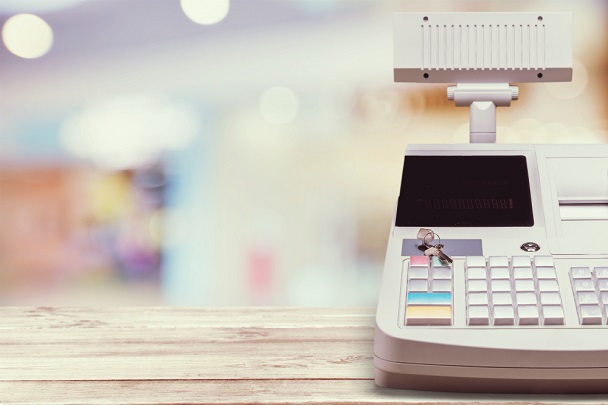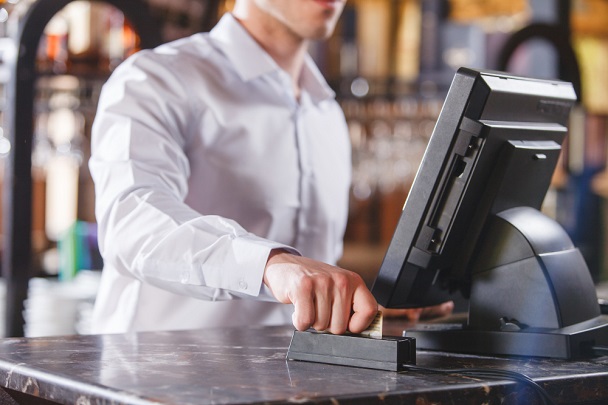
As the culinary world spins into the future, the technology at the heart of its operations—Point of Sale (POS) systems—has undergone a remarkable transformation. From the clunky cash registers of yesterday to today’s sleek, multifunctional devices that do far more than process payments. This exploration reveals how cutting-edge POS technology has become the cornerstone of efficient, customer-centric restaurant management.
Join us on a journey through time and technology where we’ll uncover how modern POS systems are not only reshaping the way restaurateurs conduct business but also enhancing the gastronomic experience for foodies everywhere.
The History and Transformation of Restaurant POS Systems

Early restaurant POS systems were simple cash registers with limited functionality.
In the early days, restaurant POS systems were just basic cash registers. The waitstaff would take the guest’s order on paper and enter it into the system using a pen. The system would then calculate the total bill, including any additional charges for extras like toast.
These rudimentary paper machines served a single purpose: to process transactions and calculate the total amount owed by customers in restaurant operations. With the advancement of restaurant technology, the sales system has become more efficient and streamlined. Traditional POS systems needed more advanced features or capabilities, making them relatively limited in their functionality for restaurant technology.
The introduction of electronic cash registers marked a significant shift in restaurant technology.
The advent of electronic cash registers brought about a significant change in the restaurant industry, replacing traditional POS systems with advanced POS software. These new restaurant POS devices replaced traditional mechanical cash registers with electronic components, allowing for more efficient transaction processing.
The restaurant POS software integrated into these devices further enhanced their capabilities. Traditional electronic cash registers, commonly used in restaurants, could perform calculations automatically and store sales data for future reference.
However, with the advancement of technology, many restaurants have now switched to using modern POS software that offers more efficient and comprehensive features compared to traditional POS systems.
With advancements in computing power, modern POS systems emerged, offering more features and capabilities.
Modern restaurant point-of-sale (POS) systems emerged as computing power improved over time. These advanced traditional POS systems offered various features and capabilities beyond simple transaction processing. The restaurant POS software was designed to streamline operations and enhance efficiency. They could track inventory levels, generate detailed reports, manage employee schedules, and integrate with other restaurant software applications.
Today’s restaurant POS systems are cloud-based, providing real-time data access from anywhere.
In today’s digital age, restaurant POS systems have evolved even further. Many modern restaurant POS solutions are now cloud-based, meaning all restaurant data is stored securely on remote servers rather than locally on individual restaurant devices.
This cloud-based approach allows real-time access to sales data from anywhere with an internet connection, making it ideal for restaurant owners needing up-to-date information. It also integrates with other restaurant business tools like online ordering platforms and customer relationship management (CRM) software.
From Traditional to Modern: The Evolution of POS Systems in Restaurants

The restaurant industry has witnessed a significant transformation in how point-of-sale (POS) systems operate. Gone are the days of traditional paper-based order-taking and cash registers in a restaurant. Modern POS systems have revolutionised how restaurants function, providing restaurateurs with advanced technology to streamline their operations and enhance customer experiences.
Digital Ordering Takes Center Stage
Traditional restaurant POS systems relied on handwritten orders and manual calculations, leading to potential errors and delays in the restaurant industry. However, with the advent of modern technology, digital ordering through touch screens or mobile devices in a restaurant has become the new norm. This shift enables restaurant servers to input orders accurately and efficiently, minimising mistakes and expediting restaurant service.
Seamless Integration with Other Technologies
Modern POS systems go beyond basic transaction processing. They seamlessly integrate with other technologies, such as kitchen display screens and online ordering platforms in a restaurant setting. This integration ensures smooth communication between front-of-house and kitchen staff, reducing order errors and enhancing overall efficiency.
Tableside Ordering for Improved Efficiency
Gone are the days when servers had to rush back and forth from tables to a stationary cash register. With wireless connectivity, modern POS systems enable servers to take orders tableside using handheld devices or tablets. This innovation saves time and improves accuracy by eliminating the need for manual order transcription.
Cloud-Based Storage for Remote Management
In the past, physical backups were necessary to safeguard essential data stored in traditional POS systems. However, modern POS solutions leverage cloud-based storage that eliminates the need for physical backups while enabling remote management capabilities. Restaurateurs can access sales reports, update menus, and manage inventory remotely from anywhere with an internet connection.
The evolution of POS systems in restaurants has brought about remarkable changes in how businesses operate today. From digital ordering and seamless integrations to tableside ordering and cloud-based storage – these advancements have undoubtedly transformed the restaurant industry for the better.
Exploring the Different Types of POS Systems in Today’s Restaurant Industry
In today’s restaurant industry, POS systems have become essential for streamlining operations and enhancing customer experiences. Let’s look at the different types of POS systems commonly used in restaurants and in hospitality sector.
Full-Service Restaurants: Robust Systems for Efficient Operations
Full-service restaurants require robust POS systems that can handle multiple functionalities seamlessly. These systems include order management, inventory tracking, and employee scheduling. With these advanced capabilities, full-service restaurants can efficiently manage their sales and inventory while ensuring smooth operations.
Quick-Service Restaurants: Compact Countertop Terminals for Speedy Service
Quick-service restaurants, known for their fast-paced operations, often opt for compact countertop terminals or handheld devices as their POS system. These systems allow quick-service establishments to process orders rapidly and meet high customer demand. The compact size of these terminals enables them to fit easily into limited counter space while still providing all the necessary functionalities.
Mobile Point-of-Sale Solutions: Portability and Flexibility on the Go
Food trucks and pop-up restaurants have found a perfect match in mobile point-of-sale solutions. These systems offer portability and flexibility, allowing vendors to serve customers anywhere without being tied down to a fixed location. With mobile POS, food truck owners can accept payments on the go and provide efficient service wherever they shop.
Self-Ordering Kiosks: Empowering Customers with Choice
Self-ordering kiosks have become an alternative option for customers who prefer a self-service experience. These interactive touch-screen kiosks enable customers to browse menus, customise their orders, and make payments directly at the kiosk. By empowering customers to take control of their ordering process, self-ordering kiosks enhance efficiency while reducing wait times.
How POS Systems are Shaping and Revolutionising the Restaurant Industry
Real-time Reporting: Making Data-Driven Decisions
Real-time reporting provided by POS systems has become a game-changer for restaurant owners and managers. They can make informed decisions about sales trends, menu optimization, and staff performance evaluation with access to up-to-the-minute data.
By analysing real-time data, managers can identify which menu items are popular among customers, allowing them to adjust their offerings accordingly. They can also track sales patterns throughout the day or week to optimise staffing levels and ensure efficient operations.
Integration with Loyalty Programs: Personalized Marketing Campaigns
POS systems have evolved beyond just transaction processing. Many now come equipped with loyalty program integrations that enable personalised marketing campaigns based on customer preferences and behaviour. By collecting and analysing customer data, restaurants can tailor promotions and offers to individual customers’ tastes and preferences. This enhances customer satisfaction and boosts customer loyalty and repeat business.
Online Ordering and Delivery Integrations: Adapting to Changing Consumer Demands
In today’s digital age, online ordering and delivery integrations have become essential for restaurants adapting to changing consumer demands. POS systems allow seamless integration with online platforms, enabling customers to place orders directly from their smartphones or computers.
This convenience factor has become increasingly important as consumers opt for delivery or takeout options. Restaurants that offer these services through POS system integrations can expand their reach and cater to a broader audience.
Contactless Payment Options: Seamless and Secure Transactions
Contactless payment options have gained immense popularity recently, especially in light of the COVID-19 pandemic. POS systems now support contactless payment methods like NFC (Near Field Communication) and mobile wallets like Apple Pay or Google Pay.
These options provide a seamless transaction experience for customers while ensuring enhanced security by eliminating the need for physical contact with payment terminals.
The Future of POS Systems: Evolving Technologies and Trends
Artificial Intelligence (AI) in POS Systems
Artificial intelligence (AI) is set to revolutionise the restaurant industry by enhancing POS systems. With AI, tasks like inventory management and predictive analytics can be automated, saving time and improving efficiency. By analysing customer data, AI-powered POS systems can provide valuable business insights, helping restaurants make data-driven decisions.
Voice Recognition Technology for Hands-Free Order-Taking
Voice recognition technology is another exciting development in the evolution of POS systems. Imagine a scenario where restaurant staff can take orders hands-free, improving speed and accuracy. This technology allows customers to place orders simply by speaking into a device or app, eliminating the need for manual input. It streamlines the ordering process and enhances the overall customer experience.
Internet of Things (IoT) Integration for an Interconnected System
Integrating Internet of Things (IoT) devices within POS systems creates a more interconnected ecosystem. Various devices, such as smart appliances, wearables, and sensors, can communicate with each other through IoT integration. For example, when a customer places an order using a mobile app, the information seamlessly flows to the kitchen display system or printer. This connectivity improves efficiency and reduces errors in order processing.
Blockchain Technology for Enhanced Security and Transparency
Blockchain technology has gained attention for its potential to enhance security and transparency in transactions. In the context of POS systems, blockchain can ensure secure payment processing for restaurant by creating an immutable record of transactions that cannot be altered or tampered with. Moreover, it provides transparency by allowing customers to trace their payments from start to finish. This level of trust instils confidence in both customers and businesses alike.
Reflecting on the Evolution and Significance of POS Systems in the Restaurant Industry
POS systems have revolutionised how restaurants operate from their humble beginnings as simple cash registers to their current state-of-the-art forms. They have become essential for streamlining operations, enhancing customer experiences, and driving business growth.
As technology advances rapidly, restaurant owners and operators must stay up-to-date with the latest trends in POS systems. By embracing evolving technologies and harnessing their power, you can unlock new levels of efficiency and profitability for your establishment.
Whether through cloud POS solutions offering real-time data insights or mobile ordering options catering to the modern customer, there are countless opportunities to leverage POS systems for success.
So, take a moment to reflect on how far POS systems have come and consider how they can propel your restaurant forward. Embrace innovation, explore different POS systems available today, and monitor emerging trends. By staying ahead of the curve and leveraging these powerful tools effectively, you’ll be well-positioned to thrive in an ever-evolving industry.
Best POS software











